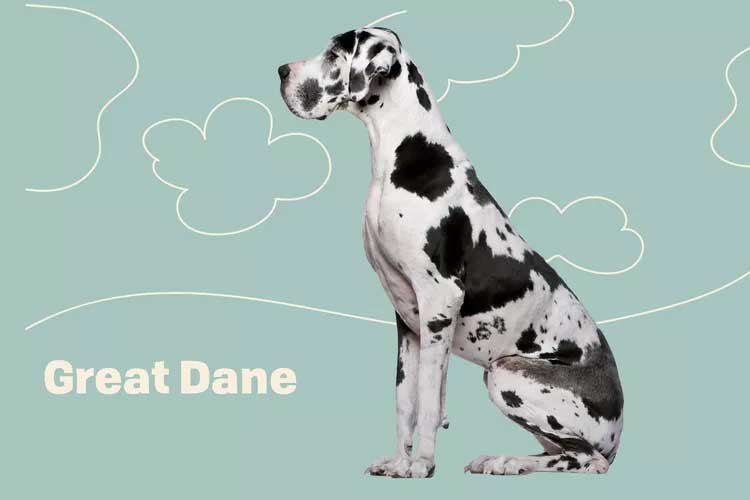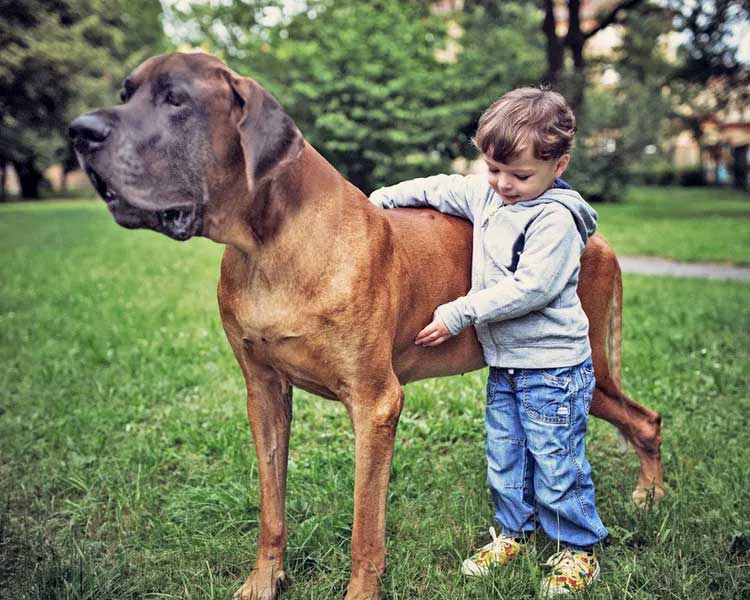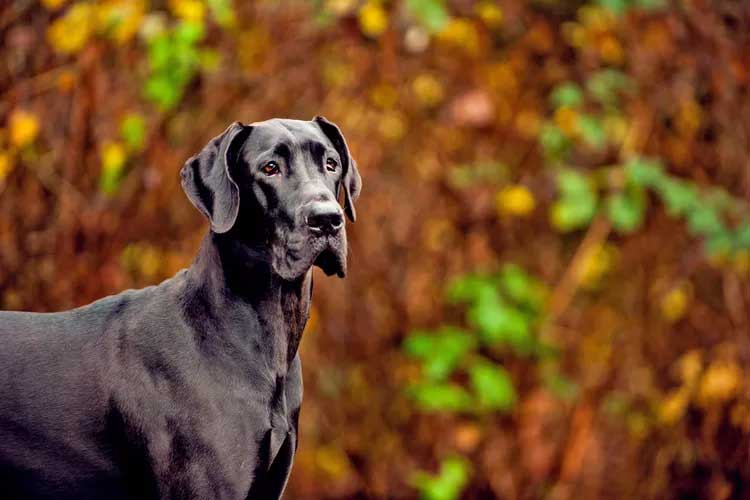Great Danes are enormous, gentle dogs that love spending time with their family, whether on walks or lazing at their elbows. Is this gentle gargantuan dog breed right for you?

Great Dane Overview
| OFFICIAL NAME | Great Dane |
| COMMON NAME | Great Dane |
| PET HEIGHT | 28 to 32 inches |
| PET WEIGHT | 110 to 175 pounds |
| LIFESPAN | 7 to 10 years |
| GOOD WITH | cats, children, dogs, families, seniors |
| TEMPERAMENT | friendly, gentle, outgoing, playful, protective |
| INTELLIGENCE | medium |
| SHEDDING AMOUNT | seasonal |
| EXERCISE NEEDS | medium |
| ENERGY LEVEL | calm |
| VOCAL LEVEL | when necessary |
| DROOL AMOUNT | high |
| BREED GROUP | working |
| BREED SIZE | extra large (101 lbs. or more) |
| COAT LENGTH | short |
| COLORS | black, blue, fawn, gray, white |
| PATTERNS | bicolor, brindle, harlequin, merle |
| OTHER TRAITS | easy to groom, easy to train, good for first-time pet owners, highly territorial, prone to health issues, strong loyalty tendencies |
A Great Dane can grow to be the size of a small horse, but don't let his large, rectangular head and lean muscles intimidate you. He's a gentle giant—a loving, loyal, and wonderful addition to any family. He cohabitates well with children and smaller animals, with proper supervision: Because he's so gangly, he might accidentally step on those shorter than him (and feel really bad about it!).
Because of the Great Dane's extra-large size, food and veterinarian bills can add up, and that often catches owners by surprise, says Jami-Lyn Derse, DVM, founder of Veterinary Housecall Care in Libertyville, Ill. "I don't think people realize how big they're going to get and how expensive they are," Derse says.
If you want a calm, loving dog and are prepared to put in the money, a Great Dane might be for you.
Appearance
The extra-large size is, hands down, this breed's defining feature. Great Danes' height spans 28–32 inches at the shoulder, and their weight can fall anywhere between 110–175 pounds. The "Apollo of dogs" is also recognizable by his long, narrow, rectangular head, deep-set eyes, and thoughtful expression. "They're very regal," Derse says. "They're strong and they're powerful, and they have a great temperament overall."
Your go-to mental image of a Great Dane might be a fawn coat and black snout, but his coat has much more range. Standard Great Dane colors include black, black and white, blue, brindle, fawn, and white.
Depending on his coat pattern, a black and white Great Dane can have a few different names. The harlequin Great Dane is defined by a white coat with irregular black patches; the merle Great Dane has a gray coat with dark patches; and the mantle Great Dane has black blanketing his body with intermittent white areas.
American Great Danes, when compared with European Great Danes, tend to have a smaller head and sleeker stature, but are otherwise similar.
Temperament
Sociable, friendly, and loving, Great Danes are simply delightful. They're terrific family dogs and, despite their towering height, are typically gentle around children, smaller dogs and cats. If you have smaller kids at home, make sure to supervise them around your Dane—after all, he's so big he might accidentally step on them.
They don't get the nickname "gentle giants" for nothing: Derse says a well-trained Great Dane is so good with kids, he'll usually be able to withstand ear- and tail-pulling young children might subject them to. "I always think of the Scooby-Doo personality; they're like that," she says.
Despite their typically calm demeanor, Great Danes were originally bred to be guard dogs and sometimes that instinct can be tapped into. Because of this breeding, as well as the dedication and love they feel toward their family, Great Danes might be wary around strangers surprising them in their yard or home. As with all dogs, make sure to socialize your Great Dane from an early age so he will be trusting and comfortable with new people and situations.
Living Needs
As social dogs, Great Danes prefer to spend time around humans and other animals rather than in solitude. A large, fenced-in yard will let them comfortably stretch their lumbering legs as desired. But as long as they get the exercise they need (we're talking two or three walks each day), a big yard isn't a dealbreaker. "They're big, so they're going to need to get out and run a little bit, but they're not these dogs that have boundless energy," Derse says. "I see them on a couch a lot of the time."In fact, it's possible for a Great Dane to get too much of a workout. The dogs grow so rapidly that, according to the Great Dane Lovers Association of Western Australia, owners should wait until their pup is 18 months old to take him hiking or jogging to preserve the his growing joints.
Care
Great Danes are big. And because of their sheer size, caring for them can get expensive. They eat more food than smaller dogs and, if taking medication, require larger doses as well. If they need surgery, they also need more anesthesia, which can raise the cost. "When you're getting one of these dogs, the cost is really something to consider," Derse says. "They're definitely more expensive."Their smooth, short coat might be low-maintenance when it comes to grooming, but Great Danes will shed occasionally throughout the year (which, given their size, can be a lot of hair). Typically, the most shedding happens in spring as weather gets warmer. To help control shedding, owners should consider brushing the dog weekly throughout the year and daily when seasonal shedding sets in. Baths are needed occasionally, and nails should be trimmed regularly. And fastidious home dwellers take note: Yes, Great Danes drool. A lot.
Training and socializing these dogs while they're young (and when you're bigger than them) is vital. Great Danes enjoy being around people and other animals, and with their eager-to-please nature, they tend to respond well to consistent positive reinforcement training.
Health
Like with most large dog breeds, the Great Dane can be prone to a number of health issues. "I always emphasize when I see a Great Dane puppy how fast they'll grow, and the diseases they get even when they are younger to middle-age," Derse says.
The Great Dane lifespan is relatively short at, 7–10 years. "These larger breeds don't tend to live as long as some of the smaller breeds, and Great Danes are one of those in particular where I think people are like, 'Oh I want to have this dog, it's going to live 12 or 14 years!'" Derse says. "And that's just not the Great Dane lifespan at all."
The biggest risk they face, Derse says, is gastric dilatation-volvulus (GDV), or bloat, a life-threatening condition that occurs when the dog's stomach fills with air and twists or flips, pressuring other organs. "You can imagine the Great Dane has a huge barrel chest, and their stomach is in there and the stomach has so much room to move around with this deep chest and deep abdomen," Derse says. "As they're running or playing, that stomach can just flip on itself."
Bloat can be prevented by a surgery called gastropexy, in which the side of their stomach is attached to the abdomen wall so it can't flip. Derse tells all Great Danes owners to have the procedure done early on. "Because once the stomach flips, and there's a good possibility it's going to, that's a life-threatening emergency," she says.

In addition, this breed is more likely to suffer from heart disease and eye conditions, autoimmune thyroiditis, hypothyroidism, and hip dysplasia. Great Dane owners should seek advice from their veterinarian about measures they can take to reduce risks and improve their dog's health.
History
The "Dane" part of the name can be confusing, but the breed has German, not Danish, origins. In his own motherland, he's referred to as the Deutsche (or German) dog.Though bred to be boar hounds and guard dogs for estates and carriages, by the late 1600s German noblemen were breeding them as pets. Today, they're more likely to serve as loyal companions rather than hunting in the field.
The AKC recognized the Great Dane as a breed in 1887, and it's still one of the 20 most popular breeds in the U.S.
Fun Facts
In 2011, a Great Dane in Otsego, Mich., named Zeus earned the Guinness World Record for "Tallest Dog Ever (Male)," measuring in at 3.66 feet tall and weighing 155 pounds (when standing on his rear legs, he measured a hulking 7 feet, 4 inches). Zeus reportedly ate 30 pounds of dog food every two weeks. He passed away in 2014, when he was 5 years old.Cartoonists love Great Danes. Scooby-Doo, Astro from "The Jetsons," and Marmaduke are all famous fictional representatives of the breed.
Politicians, athletes, and celebrities are also big fans. A few famous owners have included Jim Carrey, Bruce Lee, Fabio Lanzoni, Greg Lougainis, Mario Andretti, Chubby Checker, and President Franklin Delano Roosevelt.
There are a number of Great Dane hybrid breeds available, such as the Labradane (a cross between a Labrador retriever and a Great Dane), a Boxane (boxer meets Dane), a Great Poodane (Dane meets poodle).